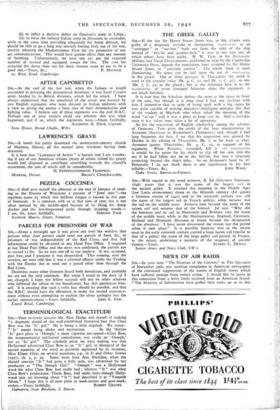THE GREEK GALLEY
SIR,—If the late Sir Henry Stuart Jones was, as Mr. Clarke says, guilty of a desperate mistake in interpreting yap* tpicria as an " outrigger " or "oar-box " built out from the sides of the ship instead of " fo'c'sle and quarter-deck " it was at any rate one of which others have been guilty. W. W. Tarn, in his Hellenistic Military and Naval Developments, published in 1930 by the Cambridge University Press, regards the translation, later accepted by Sir Henry Stuart Jones, as " certainly correct." The whole book is most illuminating. No stress can be laid upon the use of vapftteipeara in the plural. Out of three passages in Thucydides the word is used in the singular twice (Bk. 4, C. 12, and Bk. 7, C. 40): in one (Bk. 7, C. 34) in the plural; but as the reference here is to the wapefetpeelat of seven damaged Athenian ships the argument is not much fortified.
It is true that the Scholiast defines the term as the space in front of the oars, but though it is long since I had any dealings with him I remember that in spite of being spelt with a big sigma he was quite capable of making mistakes—intelligent mistakes like that of the student of Macbeth who when asked the meaning of the word " adage " said it was a place to keep cats in. And a mistake, once it has taken root, takes a lot of uprooting.
As for the reputation of English scholarship among the scholars of Germany, Tarn gives the credit of the later interpretation to Assmann (Seewesen in Baumeister's Denkmdler) and, though I had long forgotten the fact, I see that his suggestion was quoted by Holden in his edition of Thucydides, Bk. 7, as far back as 1891. Assmann quotes Thucydides, Bk. 4, C. 12, in support of his argument. When Brasidas, wounded, fell is TO ,rapettpfcriav it would be far easier for his shield to slip off his arm into the sea if he had fallen not on to the fo'c'sle, but into a structure projecting beyond the ship's sides. So on Assmann's head be it! Personally I do not think there is any significance in his first
Duke Street, Barrow-in-Furness.


























 Previous page
Previous page